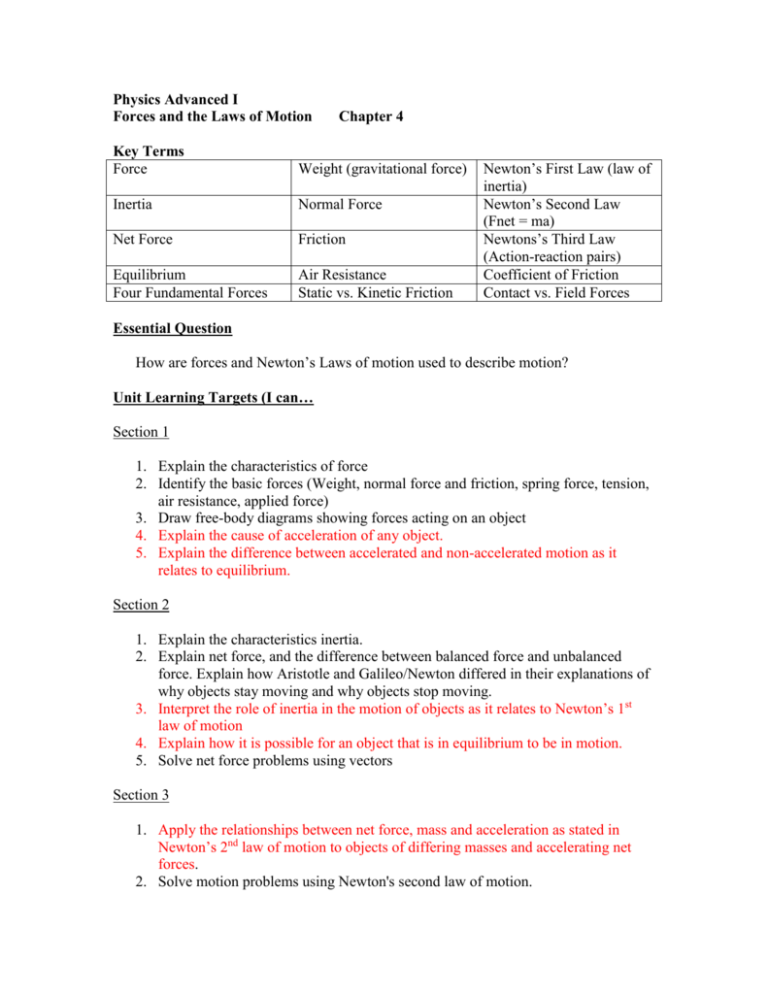Intro to Physics - Fort Thomas Independent Schools
advertisement

Physics Advanced I Forces and the Laws of Motion Chapter 4 Key Terms Force Weight (gravitational force) Inertia Normal Force Net Force Friction Equilibrium Four Fundamental Forces Air Resistance Static vs. Kinetic Friction Newton’s First Law (law of inertia) Newton’s Second Law (Fnet = ma) Newtons’s Third Law (Action-reaction pairs) Coefficient of Friction Contact vs. Field Forces Essential Question How are forces and Newton’s Laws of motion used to describe motion? Unit Learning Targets (I can… Section 1 1. Explain the characteristics of force 2. Identify the basic forces (Weight, normal force and friction, spring force, tension, air resistance, applied force) 3. Draw free-body diagrams showing forces acting on an object 4. Explain the cause of acceleration of any object. 5. Explain the difference between accelerated and non-accelerated motion as it relates to equilibrium. Section 2 1. Explain the characteristics inertia. 2. Explain net force, and the difference between balanced force and unbalanced force. Explain how Aristotle and Galileo/Newton differed in their explanations of why objects stay moving and why objects stop moving. 3. Interpret the role of inertia in the motion of objects as it relates to Newton’s 1st law of motion 4. Explain how it is possible for an object that is in equilibrium to be in motion. 5. Solve net force problems using vectors Section 3 1. Apply the relationships between net force, mass and acceleration as stated in Newton’s 2nd law of motion to objects of differing masses and accelerating net forces. 2. Solve motion problems using Newton's second law of motion. 3. Consider two objects, one with 1 kg of mass and the other with 10 kg of mass. Use Netwon’s 2nd law of motion to explain why these two objects, neglecting air resistance, fall at the same rate of acceleration. 4. Explain the fundamentals of Newton’s 3rd law of motion 5. Analyze force pairs for any interaction Section 4 1. Explain the difference between mass and weight, and how weight is related to gravitational force. 2. Solve conversion problems for mass and weight. 3. Explain the fundamentals of gravity 4. Explain the fundamentals of normal force 5. Explain the fundamentals of friction. 6. Explain the difference between static and kinetic friction. 7. Solve problems using the friction equations 8. Explain what causes air resistance to increase or decrease 9. Explain how air resistance causes different objects to fall in different manners. 10. Explain how it is possible for a falling object to stop accelerating without coming to rest. 11. Explain the characteristics of the four fundamental forces Chapter 4 Problems to Solve Problem A Textbook Problem Bank, Problem A Workbook, Problem A Problem B a) Free-Body Diagrams pg. 124 (#1-2), pg. 143 (#1), pg 145 (#7-9) (#1-3) (#1-3) Determining Net Force Forces acting in one dimension or along x and y directions, b) Textbook Workbook Problem Bank, Problem B Standardized Test Prep Pg. 145 #10, #11 Pg. 34 (#1,2) (#4, 7) Pg. 150 (#3) Two forces acting at right angles, the resultant or equilibrant Textbook Workbook Problem Bank, Problem B pg. 128 (#2, #3); pg 129, (#3); pg. 34 (#3) (#5) c) Resolving for Fx and Fy, and using Pythagorean Theorem and inverse tan to find net force d) Finding resultant or net force of two or more forces acting at angles e) Problem Bank, Problem B (#1, 2) Finding Tension in two support ropes or cables at equal but opposite angles f) Textbook pg. 128, #1; pg 145 #12 Problem Bank, Problem B (#3, 6) SAT Mathematics (#1, #2) Example problems in class, on line HW 15 Workbook pg 34 (#4) Finding net force acting on object that is on an incline Textbook pg 147 #40, 41 Problem C a. Newton’s Second Law of Motion Fnet = ma Textbook pg. 132 (#1-4), pg. 134 (#1), pg. 146 (#19, 20, 21) pg 148 (#45a) Problem Bank (#7) SAT Bellringer (#3, #4, #5) b. Finding acceleration and/or net force or mass given other information (time, velocity, horizontal or vertical displacement) Textbook pg 132 (#5), pg 134 (#4); pg 146 (#22); pg 148 #43, Workbook pg. 35 (#1, 2, 3, 4, 5) Problem Bank (1, 2, 4, 5) SAT Bellringer (#6, 7) Standarized Test Prep (#5)






